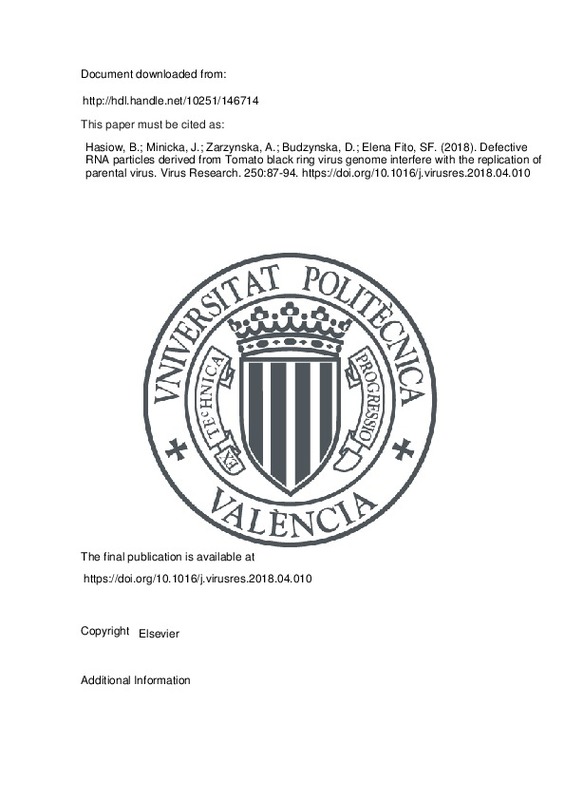JavaScript is disabled for your browser. Some features of this site may not work without it.
Buscar en RiuNet
Listar
Mi cuenta
Estadísticas
Ayuda RiuNet
Admin. UPV
Defective RNA particles derived from Tomato black ring virus genome interfere with the replication of parental virus
Mostrar el registro sencillo del ítem
Ficheros en el ítem
| dc.contributor.author | Hasiow, B.
|
es_ES |
| dc.contributor.author | Minicka, J.
|
es_ES |
| dc.contributor.author | Zarzynska, A.
|
es_ES |
| dc.contributor.author | Budzynska, D.
|
es_ES |
| dc.contributor.author | Elena Fito, Santiago Fco.
|
es_ES |
| dc.date.accessioned | 2020-06-20T03:30:30Z | |
| dc.date.available | 2020-06-20T03:30:30Z | |
| dc.date.issued | 2018-05-02 | es_ES |
| dc.identifier.issn | 0168-1702 | es_ES |
| dc.identifier.uri | http://hdl.handle.net/10251/146714 | |
| dc.description.abstract | [EN] Tomato black ring virus (TBRV) is the only member of the Nepovirus genus that is known to form defective RNA particles (D RNAs) during replication. Here, de novo generation of D RNAs was observed during prolonged passages of TBRV isolates originated from Solanum lycopersicum and Lactuca sativa in Chenopodium quinoa plants. D RNAs of about 500 nt derived by a single deletion in the RNA1 molecule and contained a portion of the 5' untranslated region and viral replicase, and almost the entire 3' non coding region. Short regions of sequence complementarity were found at the 5' and 3' junction borders, which can facilitate formation of the D RNAs. Moreover, in this study we analyzed the effects of D RNAs on TBRV replication and symptoms development of infected plants. C. quinoa, S. lycopersicum, Nicotiana tabacum, and L. sativa were infected with the original TBRV isolates (TBRV-D RNA) and those containing additional D RNA particles (TBRV + D RNA). The viral accumulation in particular hosts was measured up to 28 days post inoculation by RT-qPCR. Statistical analyses revealed that D RNAs interfere with TBRV replication and thus should be referred to as defective interfering particles. The magnitude of the interference effect depends on the interplay between TBRV isolate and host species. | es_ES |
| dc.description.sponsorship | This work was supported by the National Science Centre, Poland (grant number 2017/25/B/NZ9/01715); Ministry of Science and Higher Education, Poland (grant number IP2014 014973) (to B.H.-J.) and Spain Agencia Estatal de Investigacion-FEDER (grant number BFU2015-65037P) (to S.F.E.). The funding bodies were not involved into the design of the study, analysis, and interpretation of data in the manuscript. | es_ES |
| dc.language | Inglés | es_ES |
| dc.publisher | Elsevier | es_ES |
| dc.relation.ispartof | Virus Research | es_ES |
| dc.rights | Reconocimiento - No comercial - Sin obra derivada (by-nc-nd) | es_ES |
| dc.subject | Defective RNAs | es_ES |
| dc.subject | TBRV | es_ES |
| dc.subject | Virus accumulation | es_ES |
| dc.subject | RT-qPCR | es_ES |
| dc.subject | Interference | es_ES |
| dc.title | Defective RNA particles derived from Tomato black ring virus genome interfere with the replication of parental virus | es_ES |
| dc.type | Artículo | es_ES |
| dc.identifier.doi | 10.1016/j.virusres.2018.04.010 | es_ES |
| dc.relation.projectID | info:eu-repo/grantAgreement/NCN//2017%2F25%2FB%2FNZ9%2F01715/ | es_ES |
| dc.relation.projectID | info:eu-repo/grantAgreement/MNiSW//IP2014 014973/ | es_ES |
| dc.relation.projectID | info:eu-repo/grantAgreement/MINECO//BFU2015-65037-P/ES/EVOLUCION DE VIRUS EN HUESPEDES CON SUSCEPTIBILIDAD VARIABLE: CONSECUENCIAS EN EFICACIA Y VIRULENCIA DE CAMBIOS EN LAS REDES INTERACTOMICAS DE PROTEINAS VIRUS-HUESPED/ | es_ES |
| dc.rights.accessRights | Abierto | es_ES |
| dc.contributor.affiliation | Universitat Politècnica de València. Instituto Universitario Mixto de Biología Molecular y Celular de Plantas - Institut Universitari Mixt de Biologia Molecular i Cel·lular de Plantes | es_ES |
| dc.description.bibliographicCitation | Hasiow, B.; Minicka, J.; Zarzynska, A.; Budzynska, D.; Elena Fito, SF. (2018). Defective RNA particles derived from Tomato black ring virus genome interfere with the replication of parental virus. Virus Research. 250:87-94. https://doi.org/10.1016/j.virusres.2018.04.010 | es_ES |
| dc.description.accrualMethod | S | es_ES |
| dc.relation.publisherversion | https://doi.org/10.1016/j.virusres.2018.04.010 | es_ES |
| dc.description.upvformatpinicio | 87 | es_ES |
| dc.description.upvformatpfin | 94 | es_ES |
| dc.type.version | info:eu-repo/semantics/publishedVersion | es_ES |
| dc.description.volume | 250 | es_ES |
| dc.identifier.pmid | 29665369 | es_ES |
| dc.relation.pasarela | S\382627 | es_ES |
| dc.contributor.funder | National Science Centre, Polonia | es_ES |
| dc.contributor.funder | Ministry of Science and Higher Education, Polonia | es_ES |
| dc.contributor.funder | Ministerio de Economía, Industria y Competitividad | es_ES |
| dc.contributor.funder | Ministerio de Economía y Competitividad | es_ES |







![[Cerrado]](/themes/UPV/images/candado.png)

